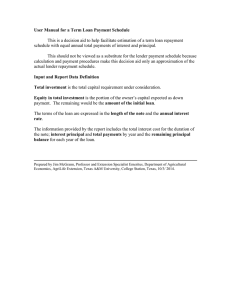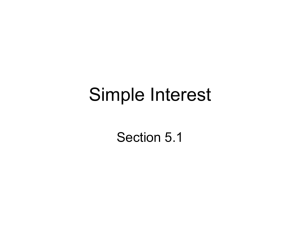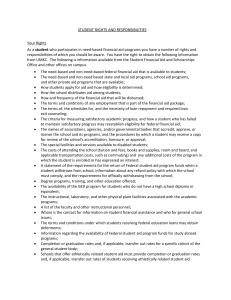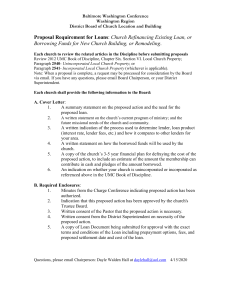Proceedings of 8th Asian Business Research Conference
advertisement
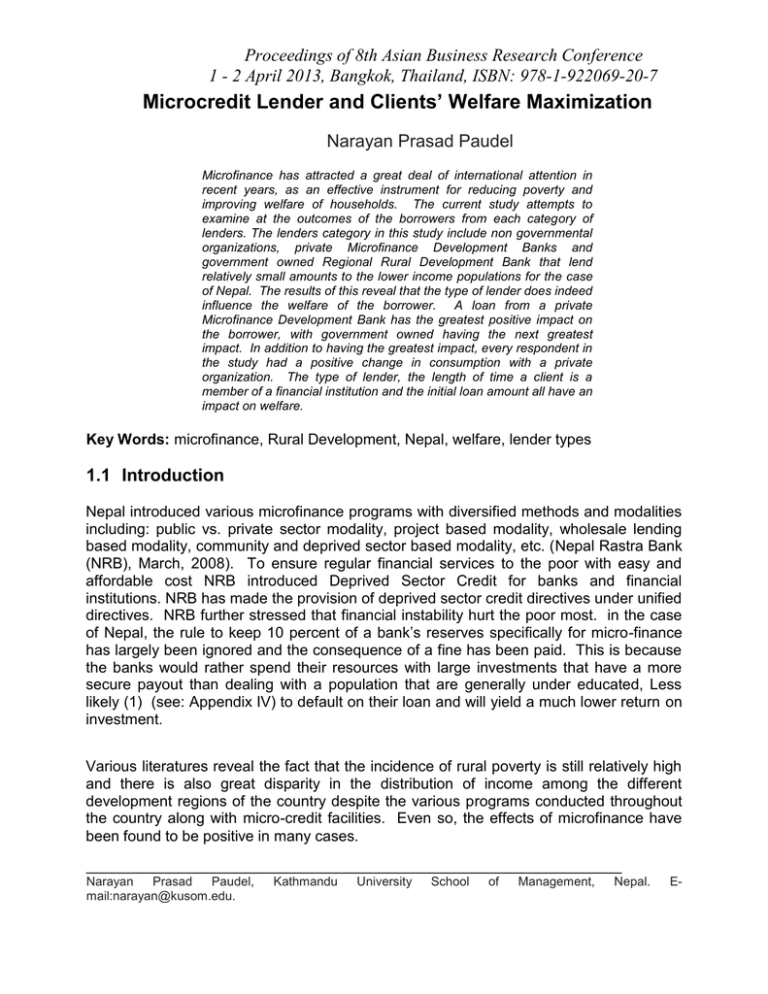
Proceedings of 8th Asian Business Research Conference 1 - 2 April 2013, Bangkok, Thailand, ISBN: 978-1-922069-20-7 Microcredit Lender and Clients’ Welfare Maximization Narayan Prasad Paudel Microfinance has attracted a great deal of international attention in recent years, as an effective instrument for reducing poverty and improving welfare of households. The current study attempts to examine at the outcomes of the borrowers from each category of lenders. The lenders category in this study include non governmental organizations, private Microfinance Development Banks and government owned Regional Rural Development Bank that lend relatively small amounts to the lower income populations for the case of Nepal. The results of this reveal that the type of lender does indeed influence the welfare of the borrower. A loan from a private Microfinance Development Bank has the greatest positive impact on the borrower, with government owned having the next greatest impact. In addition to having the greatest impact, every respondent in the study had a positive change in consumption with a private organization. The type of lender, the length of time a client is a member of a financial institution and the initial loan amount all have an impact on welfare. Key Words: microfinance, Rural Development, Nepal, welfare, lender types 1.1 Introduction Nepal introduced various microfinance programs with diversified methods and modalities including: public vs. private sector modality, project based modality, wholesale lending based modality, community and deprived sector based modality, etc. (Nepal Rastra Bank (NRB), March, 2008). To ensure regular financial services to the poor with easy and affordable cost NRB introduced Deprived Sector Credit for banks and financial institutions. NRB has made the provision of deprived sector credit directives under unified directives. NRB further stressed that financial instability hurt the poor most. in the case of Nepal, the rule to keep 10 percent of a bank’s reserves specifically for micro-finance has largely been ignored and the consequence of a fine has been paid. This is because the banks would rather spend their resources with large investments that have a more secure payout than dealing with a population that are generally under educated, Less likely (1) (see: Appendix IV) to default on their loan and will yield a much lower return on investment. Various literatures reveal the fact that the incidence of rural poverty is still relatively high and there is also great disparity in the distribution of income among the different development regions of the country despite the various programs conducted throughout the country along with micro-credit facilities. Even so, the effects of microfinance have been found to be positive in many cases. ________________________________________________________________ Narayan Prasad Paudel, mail:narayan@kusom.edu. Kathmandu University School of Management, Nepal. E- Proceedings of 8th Asian Business Research Conference 1 - 2 April 2013, Bangkok, Thailand, ISBN: 978-1-922069-20-7 The Centre for Policy Studies and Rural Development (2007) Kathmandu has found that “85 percent felt an improvement in their overall socio-economic conditions after participation in the RSRF [Rural Self-Reliance Fund] program. The study goes into further detail of the areas of the country and their breakdown of improvement. The impact of the program affected different aspects of their clients’ lives such as schooling, knowledge of health and hygiene, and nutrition. The empowerment of women within the country was also affected, the study resulted in increased female involvement in social organizations and “self-confidence in terms of ability to put their own interest” within their homes and organizations that they are a part of (Centre for Policy Studies and Rural Development, 2007). The rapidly expanding banks and financial institutions particularly micro credit development banks have contributed to increase in access to finance of the rural poor. It is evident from the NRB report (2010) that the government policy has been playing very positive role in the establishment of MFIs. It has been often found in the previous literature that the borrowers of the small loans are members of the lower income brackets and that the outcomes of these small loans have significant positive impacts on the borrowers. A question arises when wanting to see the magnitude of the impact depending on the type of issuer of the loan and the question becomes, does the type of lender impact the change in welfare of the borrower? A look is taken to see what other aspects of the lender play a role in the change in welfare that the borrower faces once they have taken out the loan. 1.2 Literature Review Microfinance Focus (2009) reports that extreme poverty affects at least 10 per cent of the population in many parts of the Asia and Pacific region, Microfinance Focus report lists 19 economies where more than 10 per cent of the populations were living on less than $1.25 a day in the latest year for which data are available. Seemi Waheed (2009 ) conducted a study in the Punjab of Pakistan looking in the effects of micro-finance on low income households. The breakdown of income of households was split into two groups, poor and non-poor which is determined by the ownership of less than four acres of irrigated land or landless, respectively. The data used to conduct the study is from secondary data collected between the years of 1999 to 2004 as well as the primary data that was collected during 2005. The results of the study showed that the types of people that applied for the micro-finance were not only the poor but also the non-poor, and both groups of people could find benefit from the loan. Also, the credit amount per capita was lower for the poor than the non-poor while the wealthier population held more credit. Banerjee, Duflo, Glennerster, & Kinnan (2009) concluded that in the short-term, microcredit may not be the miracle that it is sometimes claimed to be. It, however, does allow households to borrow, invest, and create and expand businesses. As a percentage of the population, most of the loans are held by the poor. The percentage decreases as the wealth of the household increases, until the smallest percentage of the population Proceedings of 8th Asian Business Research Conference 1 - 2 April 2013, Bangkok, Thailand, ISBN: 978-1-922069-20-7 holding loans, which is the very poor. Waheed (2009:31-47) also finds that the variables associated with education, family size, tangible and intangible assets and micro credit all had a positive significant relationship with annual income. Education and micro credit were more significant than the other factors. Waheed (2009: 31-47) concludes with a discussion about how micro-finance does not improve the livelihood of the people who participate due to the fact that the loans are used to purchase short term needs instead of long term investments. Centre for Policy Studies and Rural Development (2007) has conducted impact study of RSRF. The study aimed at evaluating the impact of Rural Self-Reliance Fund instituted by the Nepal Rastra Bank in 1991 for poverty reduction. Financial resources contributed to the Fund by the Nepal Rastra Bank and the Government are used to provide wholesale credit to the cooperatives and the NGOs at subsidized rate of interest to onlend to the poor. The policy study found that for a large majority of borrowers (62.5 percent) the fund credit was sufficient to undertake the proposed activity. Likewise, the proportion of clients reporting sufficiency of credit was 71.5 percent in the terai, 63.6 percent in the mountains and 42.4 percent in the hills. The study reports that an overwhelming majority of clients (85 percent) felt an improvement in their overall socioeconomic conditions after participation in RSRF program. The proportion reporting improved condition was the highest in the hills (91.5 percent) and the lowest in the mountains (45.4 percent), with the terai in between (85.4 percent). It is further evident from the study that all the clients have used credit for starting income generating activities with some using it for other purposes as well. The main activity has been buffalo/cow raising (43 percent), followed by retail shop (26.5 percent) and vegetable farming (14 percent). Hatlebakk (2009:70-86) finds that informal lending leads to a higher price for lending. This makes sense because when there is a disconnect in information between the lender and the borrower, the lender requires a higher payment in order to give the loan. The study was done using the LSMS data of Nepal. The results of the study show that “loan size has no significant effect on the interest rate” (Hatlebakk, 83). The high interest rates cause cycles of repayment requirement that cannot realistically be repaid causing further indebtedness. Land value is shown to be one way to determine the interest rates (Hatlebakk, 2009:85-86). Similar to the finding of Hatlebakk (2009), Daru, Churchill and Beemsterboer (2005:132154) also find that workers in southeast Asia have an extremely hard time paying back their loans. The reasons for taking out the loans have been found to “include social expenses such as religious ceremonies and dowries, investments in one’s home or household enterprise, and vices such as drinking and gambling” (Daru, Churchill and Beemsterboer, 134). Once the loans are taken, the ability to repay is found to be hard, especially to the lowest income families. In order to remove people from these cycles of non-payment, Daru, Churchill and Beemsterboer (2005:135) found that an integrated approach is best. Micro-finance along with social awareness is required to minimize the default rate. Social awareness includes training and information for the borrowers of the loans. Proceedings of 8th Asian Business Research Conference 1 - 2 April 2013, Bangkok, Thailand, ISBN: 978-1-922069-20-7 1.3. Methodology 1.3.1. Procedure of data collection Specifically, the team of research has initiated the effort to reach out to the grass-root level and engage microfinance clients in defining the impact of microfinance as a poverty alleviation strategy and clients welfare improvement. In order to examine the relationship between human development/poverty alleviation and microfinance, both quantitative and qualitative methods are used. The methodology for carrying out quantitative and qualitative field research in the study included a variety of research tools. In few of the cases an experimental group and control group is determined and categorized. Meaning is that the experimental area where researcher evaluated the implementation of the program and the control area with no exposure to the program. 1.3.1. Data The data used in the study was cross sectional data collected in 2010 in Nepal. We asked questions about the effects of the loans that the respondents had received in terms of income, consumption, assets and many other areas. The questions were all asked at the same time and referred to details from the past year and from two years ago. The questions that were particularly useful for this study were the ones that pertained to consumption and income changes, age, technology changes, the district, occupation, and initial loan amount. Appendix I: Table 1 describes the summary statistics. The variables Private, NGO, Government, Duration under two, Duration under two to four and Duration more than four are all considered as dummy variables. The variables Changes in income, Changes in consumption and initial loan amount are taken as continuous variables. The log of the continuous variables was taken to scale the values. Gender is a variable which is normally included in a study like this but was excluded because the respondents to the survey were all female. 1.3.2. Research Design One of the most important aspects of microfinance in Nepal is economic and social empowerment, which is explained in detail in the study. Besides, effective source of borrowing, interest rate structure, purpose of saving, severity of microfinance problems, major income activities of the MF clients are also assessed and analyzed. The study used the blend of descriptive as well as analytical research design to make the research more inferential and understandable. 1.3.3. Model The dependent variable in the models tested was a measure of welfare, which is not observed and may change from respondent to respondent. In that case a measure of Proceedings of 8th Asian Business Research Conference 1 - 2 April 2013, Bangkok, Thailand, ISBN: 978-1-922069-20-7 income or consumption may be used instead as can be comparable across the peoples of an area. Income can pose some problems though because of the hesitance of the respondents to answer accurately or even at all. A better measure has been found in using the information given from consumption levels. Given that the data available was panel data, to find the change in consumption, we took the difference of total consumption for the past year and total consumption for two years ago. To scale the resulting amount we took the natural log of the total consumption in each year before we differenced them. The resulting values made up the dependent variable, CHANGE IN CONSUMPTION. A variable, CHANGE IN INCOME, was created in order to see the relationship in the income and consumption patterns. Given that the patterns were different, we conclude that the reported values for income were not an accurate portrayal of welfare and conducted all following tests with CHANGE IN CONSUMPTION as the dependent variable. The independent variables that were used in this study were a combination of both continuous and dummy variables. The continuous variables that were used included CHANGE IN CONSUMPTION and INITIAL LOAN AMOUNT. CHANGE IN CONSUMPTION was represented the change in welfare that the respondent experienced. The consumption amounts were given in rupees. The natural log of each total average amount was taken in order to scale the values. Consumption was then calculated by taking the difference in the natural log of the average monthly consumption from the previous year and subtracting out the natural log of the average monthly consumption from two years ago. Initial loan amount was also given in rupees. Similar to that of consumption, the natural log of the amount loaned was taken in order to scale the values. Dummy variables were created for the model and included PRIVATE, NGO, GOVERNMENT, DURATION UNDER TWO, DURATION TWO TO FOUR and DURATION MORE THAN FOUR. The variables Private, NGO, and GOVERNMENT referred to the types of lending organizations in which the respondents belonged to. PRIVATE had a value of one if the respondent had gotten their loan from Nirdhan Bank; NGO had a value of one if the respondent had gotten their loan from Srijana Bikas Kendra; and GOVERNMENT had a value of one if the respondent had gotten their loan from Mid-western regional rural development bank (MWRRDB). The lenders were split by district as well where Nirdhan Bank was located in Banke, Srijana Bikas Kendra was only located in the Kaski, districts and MWRRDB was located in the Surkhet district. The variables DURATION UNDER TWO, DURATION TWO TO FOUR and DURATION MORE THAN FOUR represented the amount of time in which they had been a member of the financial group (PRIVATE, NGO, and GOVERNMENT). DURATION UNDER TWO refers to the clients which have been members of their respected financial group for less than two years, DURATION TWO TO FOUR refers to the clients which have been members of their respected financial group between two and four years, and finally DURATION MORE THAN FOUR refers to the clients who have been members of their Proceedings of 8th Asian Business Research Conference 1 - 2 April 2013, Bangkok, Thailand, ISBN: 978-1-922069-20-7 respected financial group for more than four years. These variables were used to see if the time that a person was a member had an impact on the welfare of the respondent. The models were derived in order to test to see which variables had the greatest impact on the welfare of the respondents. PRIVATE and DURATION UNDER TWO are excluded from the following models in order to act as the base categories. The models are estimated in the following format: CHANGE IN CONSUMPTION = + *T(x) + *M(t) + *C(y) + From the model, T(x) represents the vector of types of lending organizations. The variables that are included in that vector are GOVERNMENT and NGO. M(t) represents a vector of the time duration variables, including DURATION TWO TO FOUR and DURATION MORE THAN FOUR. C(y) represents the vector of ‘amount’ characteristics. These variables include INITIAL LOAN AMOUNT and CHANGE IN INCOME. These variables are given in rupees. The coefficients , , and give the magnitude of the impact of the type of lending organization, time duration, and amount variables respectively. represents the error term. 1.4. Discussions and Results Models one through three are run using a regular Ordinary Least Squares (OLS) regression while the fourth model is run using a logit model. The OLS regression results give the predicted impact that each variable has on the dependent variable, CHANGE IN CONSUMPTION. The logit model gives the likelihood of a change in welfare given the type of lender a respondent chooses. Graphing CHANGE IN INCOME and CHANGE IN CONSUMPTION by the different lender types gives an easier way to see the effects that each has in terms of welfare. The graph shows that GOVERNMENT had the greatest impact on the CHANGE IN INCOME. NGO has the next greatest impact with PRIVATE having the smallest impact. In terms of CHANGE IN CONSUMPTION, we see that PRIVATE gives the greatest change, with GOVERNMENT and NGO following. The differences in the impact levels of the two variables can be contributed to the unwillingness of respondents to accurately report their actual income levels. The following graph shows the average change in consumption and income over the two year period. Proceedings of 8th Asian Business Research Conference 1 - 2 April 2013, Bangkok, Thailand, ISBN: 978-1-922069-20-7 Table:1 Average change in consumption and income In Model 1, the coefficients and are set to zero so the time duration variables and the amount variables are not included. In order to see whether or not the type of lending organization changes consumption patterns, we test our first hypothesis: H0 : = 0; HA: 0. If we find that does equal zero, then we will know that the type of lending organization does not matter in changing consumption patterns. This model shows how each of the different lenders affects welfare in relation to each other. Because we know that PRIVATE will have the best result in terms of welfare, we set that variable to be the base. The results show that NGO has a statistically significant negative relationship with CHANGE IN CONSUMPTION at the 99 percent level. This shows that if a borrower were to borrow from an NGO, then their change in welfare is expected to be 24 percent less than that of a private company. GOVERNMENT does not show statistically significant results but 1, the coefficient on GOVERNMENT, is a negative 6 percent which also shows that borrowing from a government lender will have less of an effect on welfare than borrowing from a private company. Because the coefficient on GOVERNMENT is less than the coefficient on NGO, we can conclude that the second best lending entity would be a government. Appendix II: Table 2 shows the results of the regression. Model 2 takes into account how long the borrower has been a member of the financial organization as well as the type of lender the financial organization is. The variable is set to zero in order to see the affects of the time variables and the organization types. The hypothesis tested is H0: = 0; HA: 0. If we do Proceedings of 8th Asian Business Research Conference 1 - 2 April 2013, Bangkok, Thailand, ISBN: 978-1-922069-20-7 find that is zero, then we would conclude that how long a person has been a member of a financial institution does not matter. The significance levels, signs and magnitudes for the type of lender are very similar to that of Model 1. The variables that take into account how long a client has been a member do not prove to be statistically significant but have positive values. This result is as expected because the base variable refers to if a client has been a member for less than two years. We would expect that the longer the client has been a member of a financial organization, the greater the impact on their welfare would be. We see that if the membership time increases one year then the CHANGE IN CONSUMPTION would change about 6 percent, regardless of if membership is between two and four years or if greater than four years. Appendix II: Table 2 shows the results of the regression. The third model adds in the effect of the initial loan amount and the change in income, then controls for the CHANGE IN INCOME. The hypothesis tested is H0: = 0; HA: 0. If we find that does equal zero, then these amount variables do not matter in the changes in consumption. We see that the type of lender is now significant at least at the 95 percent level and the length of membership is significant at the 90 percent level. The signs on the coefficients do not change but the magnitudes do change. GOVERNMENT has a 12.9 percent smaller impact and NGO has 24.7 percent smaller impact than PRIVATE on consumption. When increasing the membership at a financial institution by a year, the CHANGE IN CONSUMPTION is affected by almost 15 percent in either case. The result for the initial loan amount is somewhat counter intuitive in that it is a negative relationship, which means that as the initial loan amount is increased by one percent, the impact on welfare is reduced by 7.7 percent. Appendix II: Table 2 shows the results of the regression. Model 4 is a logit model which describes the likelihood levels of a CHANGE IN CONSUMPTION from the different lender types. Similar to Model 1, and are set to zero. GOVERNMENT is used as the base in this model instead of PRIVATE like was originally used in Model 1. The hypothesis tested is the same as in Model 1, H0 : = 0; HA: 0. The standard error for PRIVATE is omitted from the results because of perfect predictability. This tells us that everyone in the sample who had received a loan from a private lender had a positive impact on CHANGE IN CONSUMPTION. We know that not everyone had a positive CHANGE IN CONSUMPTION which tells us that not every case of microfinance is one which increases welfare. The results of this regression can be seen in Appendix III: Table 3. 1.5. Conclusion and implications Despite of gradual development of microfinance activities in Nepal still the country has experienced some fundamental problems and issues in microfinance including problems in identifying target groups, identifying potential projects that can be easily managed by the client’s needs. The results of this study show that the most important aspect of improving welfare when using micro-finance is the Proceedings of 8th Asian Business Research Conference 1 - 2 April 2013, Bangkok, Thailand, ISBN: 978-1-922069-20-7 type of lender. The type of lender has shown in this case to be the most significant on the change in welfare, with a private lender having the greatest impact. We also found that every borrower who had gotten their loan from a private company had an increase in their consumption over the two years. The reasons behind why this is true for private companies and not for government and non governmental organizations should be researched. Then changes could be made to the other types of organizations in order to increase the benefit for the borrowers. The curious result of a negative coefficient on the initial loan amount shows that a small loan can have a positive impact on welfare but as that amount increases, the smaller that impact becomes. This shows that the structure of the loans, the interest rate and payback outline, are geared towards small loans and should be used in these cases. When the loans reach a certain point, a different structure should be applied in order to maximize the benefits for both the lender and the borrower. Data that would be useful in furthering this study would be some of the practices of each of the lenders. This would include the training and information that each lender has for its clients both before and after they receive a loan. If the practices are formal, the client may behave more responsibly with the money and have a better outcome in terms of welfare. The process the lender takes when collecting the money may have an impact on how clients use the money they receive from a loan as well. An interesting bit of information would have been the default rate of each type of lender. This could be used to see if micro-finance is being used for the reasons the clients first specified and how that affects welfare. References Banerjee, A., Duflo, E., Glennerster, R. & Kinnan, C. (2009). ‘The Miracle of Microfinance? Evidence from a Randomized Evaluation: Assessing impact of credit expansion using randomized evaluation’. Centre for Policy Studies and Rural Development (2007). ‘Impact Study of Rural Self Reliance Fund Credit Program’. Kalimati, Kathmandu. Daru, P; Churchill C and Erik B. (2005). ‘The Prevention of Debt Bondage with Microfinance-led Services’. The European Journal of Development and Research Volume 17(1), pp. 132-154. Hatlebakk, M. (2009). ‘Capacity-constrained Collusive Price Discrimination in the Informal Rural Credit Markets of Nepal.’ Review of Development Economics 13(1), pp. 70-86. Microfinance Focus (2009). ‘Microfinance and Sustainable Development’. A global monthly E magazine. Proceedings of 8th Asian Business Research Conference 1 - 2 April 2013, Bangkok, Thailand, ISBN: 978-1-922069-20-7 Nepal Rastra Bank (2008). Groups in Nepal: ‘Micro-financing towards Empowerment of Disadvantaged Innovations and Practices’. Micro Finance Department National Microfinance Vision 2015. Waheed, S. (2009). ‘Does Rural Micro Credit Improve Well-Being of Borrowers in the Punjab (Pakistan)?’ Pakistan Economic and Social Review Volume 47, pp. 31-47. Appendix I Table 1: Descriptive Statistics Variable Description Observations Mean Change in Percentage change Income in Income 286 .438 Change in Percentage change Consumption in Consumption 299 .306 Private Private Lender 301 .332 Non-government NGO Lender 301 .329 Government Government Lender 301 .332 Length of Duration Membership under 2 Under Two years 301 .163 Length of Duration Two Membership to Four between 2 - 4 years 301 .342 Length of Duration More Membership more than Four than 4 years 301 .485 Initial Loan Log of Initial Loan Amount Amount 298 9.429 Source: Field survey 2010 Std Dev Min / Max .638 -0.845 / 9.17 .385 .472 -1.386 / 1.954 0/1 .471 .472 0/1 0/1 .370 0/1 .475 0/1 .501 0/1 .687 7.601 / 11.156 Proceedings of 8th Asian Business Research Conference 1 - 2 April 2013, Bangkok, Thailand, ISBN: 978-1-922069-20-7 Appendix II Table 2: Regression Results for Models 1 , 2, and 3 Model 1 Model 2 Model 3 Variable Coefficient Std. Error Coefficient Std. Error Coefficient Std. Error Government -.065 .053 -.069 .061 -0.13** .051 NGO -0.245*** .053 -0.234*** .055 -0.247*** .059 Duration Under Two .064 .066 0.147* .086 Duration More than Four .061 .067 0.149* .088 Initial Loan Amount -.010 .030 Change in Income .077 .055 Number of Observations: 299 299 286 R Squared: .073 .076 .111 * refers to significance at 10% ** refers to significance at 95% *** refers to significance at 99% Source: Field survey 2010 Appendix III Table 3: Regression Results for Model 4 Variable Coefficient Std. Error Z Private -13.416 . . NGO -13.426 1.424 -9.43 Number of Observations: 299 Pseudo R Squared: 0.0681 Source: Field survey 2010 Appendix IV Less likely (1) = result indicates that microfinance loan default on payment is less than the default rate on large loan amount.

